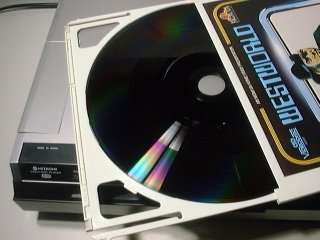Capacitance Electronic Disc

Quite possibly the strangest and most obscure of all media formats, the Capacitance Electronic Disc (CED) was a video disc format developed by RCA that was released in 1981 under the brand name "SelectaVision". It is essentially a record-sized disc like its cousin the LaserDisc, except encased in a plastic cover and read by a record-like stylus. You play the disc by inserting the cover into the player (which the player would eject the disc), sliding the cover out, then flipping a switch to lower the disc onto a turntable to play.
RCA first developed the CED format in 1964 as a way to reproduce video similar to phonograph records. The discs were initially meant to be held by hand, but test audiences often accidentally smudged or scratched them, causing the quality to degrade in those areas. This led to creating the aforementioned covers to protect the delicate discs. The prototype discs were also made of poor quality materials that would deteriorate very quickly leading to skipping issues and eventual damage to the player, forcing RCA to come up with a solution to solve this problem and delaying its initial 1977 release for four years.
By the time CED made its way onto the market, there already were several problems, despite its low price compared to the competition. For one, they held only 30 minutes per side, forcing users to get up and flip the disc to get to the next part of their movie, or switch discs if the movie were longer than 60 minutes. Plus, they lacked recording capabilities, unlike VHS and even Betamax. Also, they had a much shorter lifespan than its competitors—about 500 plays maximum—and the stylus needed to be changed periodically to avoid damage. Because of this, RCA was only able to sell about half of the expected 200,000 players in early 1982, and eventually discontinued CED in 1986.
Despite all its shortcomings, CED had some advantages. Both the discs and players were less expensive than VHS and Betamax due to the record-like pressing technology of the discs and fewer moving parts in the players. You can seek out chapters similar to LaserDisc and even the DVDs and Blu-Rays of today, allowing you to quickly access certain parts of the movie. Also, you never had to touch the discs thanks to the covers.
More information about CED can be found here.